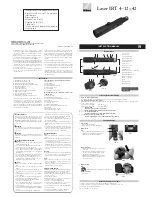
1
IN 254 Rev B 01/09
Customer Support (800) 676-1343
Email: [email protected]
Corporate Offices (831) 763-7000
89 Hangar Way, Watsonville, CA 95076
Providing Exceptional Consumer Optical Products Since 1975
Orion
®
GrandView
™
100mm
#52102 20-60x100mm Zoom Spotting Scope
Congratulations on your purchase of a quality Orion spotting scope.
Your GrandView 100mm zoom spotting scope is a high-quality opti-
cal instrument for viewing birds, wildlife, sports events, or anything
else you want to see more closely. Its large aperture will provide
bright, sharp images even in low-light situations. Before using your
spotting scope, we recommend that you read through the following
instructions.
Attaching to an Optional Tripod
The GrandView 100mm spotting scope can be attached to a sturdy
camera tripod or other mount by use of the 1/4"-20 threaded hole
in its mounting block. This hole accepts 1/4"-20 mounting studs
that are standard on most tripods.
The spotting scope can be rotated relative to the mounting block,
should you wish to change the orientation of the eyepiece for a
more comfortable viewing angle. With the spotter attached to a
tripod, loosen the thumbscrew on the mounting block’s ring, and
grasp the body of the spotting scope. Rotate it to the desired posi-
tion, and re-tighten the thumbscrew when done.
Extending the Lens Shade
A nice feature of the GrandView 100mm is its retractable lens
shade. Having a retractable lens shade is desirable, as it keeps the
length of the spotting scope shorter, and thus more portable, when
transporting it.
When using the spotter, especially in bright daylight, the lens shade
helps reduce glare (stray light) from entering the field of view. Glare
is undesirable because it decreases overall image contrast. To use
the lens shade, extend it by grasping its large, knurled rubber ring
and pulling it outward from the spotter’s body. A twisting motion can
aid in doing this. Retract the lens shade before putting the spotting
scope back into its case.
Focusing
Point the spotting scope in the general direction of an object at
least 25 feet away. Rotate the focus knob with your fingers until the
object comes into sharp focus. Go a little bit beyond sharp focus
until the image just starts to blur again, then reverse the rotation of
the knob, just to make sure you’ve hit the exact focus point.
Using the Zoom Eyepiece
The GrandView 100mm provides continuous zoom magnifica-
tion from 20x to 60x. The magnification is adjusted by rotating
the knurled rubber zoom ring on the eyepiece. The arrow indica-
tor and magnification scale show the current magnification setting.
Changing the magnification may also require slight refocusing to
achieve the sharpest image.
For general use, it’s a good idea to start viewing at the lowest mag-
nification (20x) until you’ve acquired your viewing target. Then you
can zoom-in to a higher magnification to see more detail. Note that
as magnification increases, the images will become dimmer; this is
an inherent law of optics, and cannot be avoided.
Roll-Down Eyecups
The spotting scope features a roll-down eyecup on the zoom eye-
piece. This eyecup is usually left in the up position for use without
eyeglasses. To use the spotting scope with eyeglasses, simply roll
down the eyeguard by folding it down on one side, then sliding your
fingers around the eyeguard’s rim.
Using the Sighting Nubs for Aiming
The GrandView 100mm comes with built-in sighting nubs. These
are the two raised features in the rubber armoring near the eye-
piece. The nubs come in quite handy for aiming the spotter at an
object you wish to view.
To use the sighting nubs, look down the left side of the spotter until
the rubber nub closest to your eye is precisely in-line with the rub-
ber nub further down the spotter’s body. Now, aim the scope so the
object you wish to view is also in-line with the sighting nubs. Set the
zoom eyepiece to the lowest (20x) magnification, and the object
should be somewhere within the field of view.
Care and Maintenance
Although the GrandView 100mm is durable and waterproof, it
should avoid prolonged, unnecessary exposure to the elements.
Keep the spotter in its case and indoors when not in use.
If it gets splashed with water, or is used in the rain, the spotting
scope will not be harmed. It is internally purged with nitrogen and
sealed, so water on the body or optics is not a problem. Simply
wipe water off the body with a cloth or towel and use lens tissue to
dry the objective and eyepiece lenses after a wet observing ses-
WARNiNG:
Never look directly at the Sun
through your spotting scope—even for an
instant—without a professionally made solar
filter that completely covers the front of the
instrument, or permanent eye damage could
result. Young children should use this spotting
scope only with adult supervision.
Eyepiece Thumbscrew Mounting block
Zoom ring Focus knob Lens shade Objective lens
















